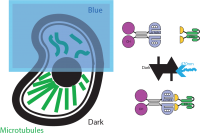Cellular architecture and behaviour is largely dependent on the organization and dynamics of the microtubule cytoskeleton. Coordination of microtubules inside cells are regulated by diverse microtubule-binding proteins, which in turn recruit effector proteins that control microtubule growth. A recently published paper in Nature Cell Biology from Torsten Wittman’s lab at UCSF illustrated the development of a novel optogenetic system to manipulate microtubule organization. van Haren et al. used targeted light stimulation to precisely inactivate the microtubule-binding protein End-binding protein 1 (EB1), which is responsible for binding microtubules and recruiting plus-end-tracking proteins (+TIPs) to their positive ends.

Targeted inactivation of EB1 was achieved by employing Mightex’s DMD-based Polygon400 pattern illuminator that allowed the resarchers illuminate multiple, discrete, high-contrast patterns at the same time. In this paper, the Polygon400 was coupled to the spare camera port on the microscope to enable simultaneous imaging (spinning disk) and targeted photostimulation (Polygon400). Select areas of the cell were illuminated using the Polygon400 and illumination was synchronized with the camera via TTL pulses, such that the camera would trigger 10-20ms pulses of blue light from the Polygon400 in between image acquisitions. The intermittent short pulses of blue light stimulation removed any scattered photostimulation light from the imaging.
The researchers were able to locally induce photodissociation of EB1 within cells and disrupt microtubule organization in those regions of interest. In one particularly elegant experiment, van Haren et al. showed that local EB1-dissociation-based microtubule disruption led to a change in orientation of the migrating leading edge of cancer cells. With the Polygon400, the researchers were able to generate an optical cage, such that cancer cells within a projected blue-light boundary would change direction once they reached the blue-light and thus, they would be trapped within the optical cage. These findings implicated the role of EB1 interaction with +TIPs in maintaining the directionality of migrating cells. van Haren et al. show how the development of optogenetic probes for cell biology combined with the Polygon400 DMD-based technology opens the door for new intriguing findings in the cell biology field.
To read the full paper published in Nature Cell Biology, click here.
van Haren, J., Charafeddine, R.A., Ettinger, A., Wang, H., Hahn, K.M., & Wittmann T. (2018). Local control of intracellular microtubule dynamics by EB1 photodissociaton. Nature Cell Biology.



